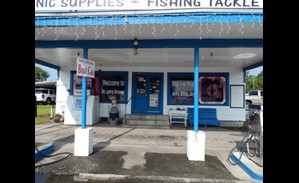
For Immediate Release
Monday, June 26, 2017
Contact: Sarah Revell
850.245.6522
[email protected]
Secretary Detzner Announces the Designation of Nine Florida Properties on the National Register of Historic Places
TALLAHASSEE, Fla. –
Secretary of State Ken Detzner today announced that nine properties in Florida have been listed on the National Register of Historic Places so far in 2017. Bo Lynn’s Grocery in St. Marks, the Coconut Grove Library in Miami, the Cox Family Log House in Gainesville, Devil’s Millhopper Geological State Park in Gainesville, the First Clewiston Post Office in Clewiston, the Naval Air Station Richmond Headquarters in Miami, Rose Hill Cemetery in Tarpon Springs, the Santa Rosa Hotel in Sebring and the Tallahassee Fire Station No. 2 in Tallahassee have all been recognized for their historical significance by the National Park Service with their listing on the National Register of Historic Places.
“I am pleased to announce the addition of this diverse group of properties on the National Register of Historic Places,” said Secretary Detzner. “Together, they illustrate Florida’s array of architectural and cultural heritage worthy of preservation.”
Bo Lynn’s Grocery is a small wood frame grocery store and gas station located in the Town of St. Marks, south of Tallahassee. The oldest commercial retail building in St. Marks, it has been in continuous operation since its construction by J. T. “Bo” Lynn in 1936.

The store served for much of its history as the largest grocery and gas station in St. Marks, and provides the town with a wide variety of goods, including groceries, gasoline, clothing, automotive and boat parts, and fishing supplies.
The Town of St. Marks was founded shortly after the U.S. acquired Florida in 1821. It served as a port for the City of Tallahassee and as a railroad hub. Today, St. Marks is the last remaining antebellum town located on the St. Marks River. Bo Lynn’s Grocery continues to serve the St. Marks community and has been owned and operated by Joy Brown since 1965.
The Coconut Grove Library in Miami was constructed in 1963 and replaced an earlier library building built on the same site in 1901.The 1901 library was housed in a small building constructed with funds raised by the Coconut Grove Library Association. The Library Association operated the institution until 1957, when the City of Miami offered to build a new air-conditioned facility.

The new library, designed by architectural firm T. Triplett Russell in the Tropical Modern Style, was completed and opened to the public in 1963. The design of the present-day library is distinguished by a wraparound veranda screened by metal Bahama shutters and a clipped gable structure faced with random rubble oolitic limestone which evokes the appearance of the original 1901 library.
The property is also the gravesite of Eva Munroe, the wife of pioneer Commodore Ralph Monroe. She died in 1882 and was buried on the site in 1884. Today, the Coconut Grove Library continues to serve local patrons as an active public library.
The Cox Family Log House in Gainesville is an unusual residential adaptation of rustic style architecture. The National Park Service and U.S. Forest Service are generally credited with developing the rustic architectural style during the Great Depression. Applied to buildings, bridges, signs and other structures in national parks, rustic style buildings reflect colonial and early American antecedents.

Constructed of rough-hewn, locally produced cypress wood and stone chinked with mortar, the Cox Family Log House is a good example of this architectural style.
O’Neal and Mary Cox, owners of Cox Furniture in Gainesville, built the Log House in 1937 and lived there until 1972. Today, the home remains a private residence.
The Devil’s Millhopper Geological State Park in Gainesville includes one of the state’s most significant sink holes. Designated a National Natural Landmark by the National Park Service in 1974, the more than one hundred-foot-deep sinkhole has been a place of human habitation for over 10,000 years, and has attracted tourists for more than a century. The sinkhole’s more recent history includes the park’s entry gates, a 1938 Civilian Conservation Corps project, as well as a trail down the western slope of the sinkhole and a trail around the sinkhole.

The State of Florida acquired the property in 1974 to protect the park’s geological features and interpret them for the public. Today, the public can visit this active state park for hiking, viewing wildlife, picnicking, tours and exhibits. To schedule your next visit, go to FloridaStateParks.org/park/Devils-Millhopper.
The First Clewiston Post Office was constructed in downtown Clewiston between 1926 and 1930 as the city’s post office and telephone company. The Mediterranean Revival style building was designed by architect Clarke J. Lawrence of Palm Beach, who also designed several other buildings in Clewiston.

It is a distinctive example of Mediterranean Revival style applied to a small commercial building, during the early development of Clewiston as a partly planned community.
The Mediterranean Revival style was the most popular architectural style in Florida during the 1920s, and contains architectural elements derived from the area around the Mediterranean Sea, especially Italy and Spain. The building currently houses a retail business.
The Naval Air Station Richmond Headquarters Building in Miami served as the operational headquarters for the Navy’s “Lighter Than Air” operations along the Gulf of Mexico in Florida and the Caribbean during World War II. When the Headquarters Building was completed in 1942, it was one of the largest blimp bases in the world with three massive hangars. Blimps stationed at Richmond were part of an elaborate military response to heavy losses of merchant vessels early in World War II.

After the war, the Central Intelligence Agency (CIA) used the Headquarters building extensively, including use as the headquarters for CIA covert operations in Miami, with the codename JMWAVE. At the height of the Cold War, JMWAVE was the largest CIA field station in the world. Today, the building is being restored as the Military Museum of South Florida, and is scheduled to open to the public on September 16, 2017. Visit SouthFloridaMilitaryMuseum.org for more information.
Rose Hill Cemetery in Tarpon Springs is a significant historic cemetery that preserves a strong African-American identity. Established in 1916 in response to segregationist policies, the cemetery has remained in constant use to the present day and includes more than 1,000 grave plots of African-Americans from Pinellas County.

The cemetery’s earliest recorded burial dates to 1904, but the property is believed to have been used by the black community as a cemetery since the 1870s.
Gravestones include both commercial and handmade examples in a variety of materials, including granite, marble, concrete, wood and stainless steel. Cultural beliefs from African and southern American traditions are apparent in the east-west orientation of graves, positioning of couples, chairs and benches, and decorative elements on the graves such as conch shells and symbols engraved on the markers.
The Santa Rosa Hotel is one of nine small tourist hotels constructed in Sebring during the Florida Real Estate Boom of the mid-1920s. These hotels catered to traveling businessmen and vacationers.

The Santa Rosa Hotel was constructed in 1923 by Aaron Withers, a prominent member of Sebring’s founding generation. At that time, the brick masonry hotel cost $75,000 to build and featured 30 guest rooms, each with a private bath.
The Santa Rosa operated as a hotel until 2004 when three hurricanes struck Sebring in an eight-week period, seriously damaging the building. The current owners are in the process of renovating the building to reopen it as a hotel.
Tallahassee Fire Station No. 2 was built in 1951 in Tallahassee. It was designed by architect James A. Stripling and Associates and was constructed by J. O. Carlile Builders. The fire station was designed to serve what was then the northern part of Tallahassee, and to accommodate an automotive maintenance shop. But the station went far beyond maintenance, as one of the first fire stations in the state to convert surplus military vehicles for use as fire trucks.

In 1951, the Florida Civil Defense Act was passed and state governments were offered surplus military equipment from the federal government. The City of Tallahassee Fire Department used the Civil Defense Act to procure surplus military vehicles and equipment until at least 1961. The vehicles were torn down to the chassis at this station’s automotive maintenance shop and rebuilt as fully functional fire engines. Fire Station No. 2 was used for active fire service until 2001 and today houses private offices.
# # #
About the National Register of Historic Places
The National Register of Historic Places is a list maintained by the National Park Service which includes historical or archaeological properties including buildings, structures, sites, objects, and districts, that are considered worthy of preservation because of their local, statewide and/or national significance. Nominations for properties in Florida are submitted to the National Park Service through the Florida Department of State’s Division of Historical Resources. Florida has more than 1,700 listings on the National Register, including 292 historic districts and 173 archaeological sites. There are more than 50,000 sites contributing to the National Register in Florida. For more information, visit flheritage.com/preservation/national-register. For more information about the National Register of Historic Places program administered by the National Park Service, visit nps.gov/nr.
About the Bureau of Historic Preservation
The Florida Department of State’s Bureau of Historic Preservation (BHP) conducts historic preservation programs aimed at identifying, evaluating, preserving and interpreting the historic and cultural resources of the state. The Bureau manages the Florida Main Street Program, and under federal and state laws, oversees the National Register of Historic Places program for Florida, maintains an inventory of the state's historical resources in the Florida Master Site File, assists applicants in federal tax benefit and local government ad valorem tax relief programs for historic buildings, and reviews the impact that development projects may have on significant historic resources. For more information, visit flheritage.com/preservation.
